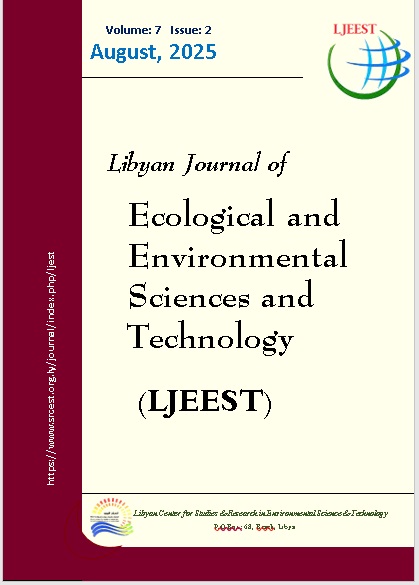Call for Papers
Libyan Journal of Ecological & Environmental Sciences and Technology (LJEEST)
Volume, 08 No. 1 April. 2026
Submission Deadline for this Issue: 21 March 2026
Read more about Call for PapersThe Libyan Journal of Ecological and Environmental Sciences & Technology is the leading academic journal in its field. It publishes high quality, peer-reviewed original research articles, promoting significant advances in environmental sciences and technology. The journal aims to contribute significantly to the scientific community by addressing pressing environmental challenges and promoting sustainable practices. It is published by the Libyan Center for Studies and Research in Environmental Sciences and Technology.
Libyan Journal of Ecological & Environmental Sciences and Technology (LJEEST)
Volume, 08 No. 1 April. 2026
Submission Deadline for this Issue: 21 March 2026
Read More Read more about Call for Papers
With the release of the second issue of Volume 7, the Libyan Journal of Environmental Science and Technology Research reaffirms its unwavering dedication to fostering scientific inquiry within the critical domains of environmental science and sustainable technology. The journal continues to serve as a vital academic platform, contributing to the enrichment of knowledge and facilitating the development of innovative solutions to address the escalating environmental challenges of our time.
In an era marked by profound environmental shifts, ranging from the intensification of climate change and the scarcity of natural resources to the urgent imperative for adopting sustainable solutions across industrial and agricultural sectors, scientific research remains the cornerstone for understanding and effectively responding to these transformations. The Libyan Journal of Environmental Science and Technology Research prioritizes the dissemination of high-quality scientific content that reflects the latest advancements in these fields, providing researchers with a crucial avenue to share their insights and findings with the global academic and scientific community.
Driven by our vision to enhance the dissemination of scientific research through modern and efficient methodologies, this latest issue continues its digital presence via the Open Journal Systems (OJS) platform and the journal’s newly redesigned website. This transition represents a significant advancement in the management of scholarly journals, offering a sophisticated digital environment that streamlines the entire publication process, from manuscript submission and peer review to online publication in accordance with the highest academic standards. This platform enhances accessibility to scientific research, promotes transparency and quality, and empowers researchers to leverage published knowledge for their future studies.
This issue features a diverse collection of research articles addressing globally significant environmental issues, including studies related to climate change, the impact of industrial activities on ecosystems, renewable energy technologies, and the more sustainable management of natural resources. We anticipate that these contributions will provide valuable insights, deepen scientific understanding, and support the efforts of researchers in developing practical solutions to address pressing challenges.
It is with great pleasure that we witness the continued growth in the journal’s content, with an increasing number of scholarly contributions offering novel perspectives and pioneering ideas that contribute to the advancement of the environmental and technological fields. The editorial board remains steadfast in its commitment to further enhance this academic platform, ensuring it serves as an impactful scholarly resource for researchers and specialists alike, thereby supporting the trajectory of scientific research as the bedrock for achieving a sustainable and balanced future.
We extend our deepest gratitude and appreciation to all the researchers and contributors who have enriched this issue, and we encourage all academics and experts to continue their research endeavors and contribute to the advancement of environmental and technological knowledge, given its direct impact on the future of humanity and nature. Science is the pathway to progress, and academic collaboration is the most crucial means to achieving the ambitious environmental goals we collectively strive for.
Sincerely,
The Editorial Board
Libyan Journal of Ecological and Environmental Sciences and Technology
P.O.Box: 68, Brack Al-Shatti, Libya Phone: +218715122430-31 e-mail: info@srcest.org.ly
ISSN: 2710-5237 (electronic) & (print) 2710-5229
All articles published in the journal are licensed
under: Creative commons (CC BY-NC)
